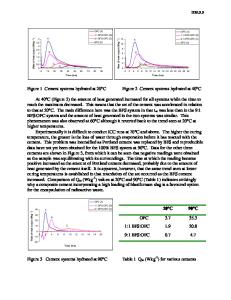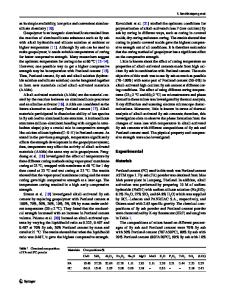Microstructure and Porosity of Metakaolin Blended Cements
- PDF / 824,813 Bytes
- 6 Pages / 420.48 x 639 pts Page_size
- 32 Downloads / 379 Views
MICROSTRUCTURE AND POROSITY OF METAKAOLIN BLENDED CEMENTS P. BREDY, M. CHABANNET and J. PERA Laboratoire des Mat6riaux Mineraux, Bat. 307, INSA de Lyon, 20, Avenue Albert Einstein, 69621 Villeurbanne Cedex, France Received 30 November, 1988; refereed ABSTRACT Five compositions with 10% to 50% metakaolin for cement substitution were studied. The rate of hydration was studied from the compressive strength after up to 6 months of curing and from the hydrates formed (DTA-XRD). The metakaolin addition considerably reduced portlandite content in the hydrated cement and contributed to the formation of hydrated gehlenite which is not present in OPC paste. The microstructure study (SEM) shows that pozzolanic cement pastes were less crystallized than plain pastes. Mercury intrusion was used to measure porosity of hydrated cement pastes. The porosity with blended cements was higher than that with OPC, except for 10 and 20% metakaolin substitution. Evolution of the pore size distribution was studied: the pozzolanic pastes enhance small diameters.
INTRODUCTION
Porosity and pore size distributions are parameters that affect some of the basic properties of concrete such as strength, permeability and durability [1-4]. The objective of the study reported in this paper was to investigate pore structure development of hardened metakaolin blended cement pastes. After calcination at moderate temperature (700-800oC), kaolin shows interesting pozzolanic properties when mixed with OPC and water [5-6]. A structure change occurs with a more or less sensible disorganization of the crystal lattice corresponding to the formation of a transition phase, metakaolin, which presents a high reactivity. EXPERIMENTAL PROCEDURES
Five compositions with 10% to 50% cement substitution by metakaolin were studied. The cement used was an ordinary Portland cement (OPC), Class 55 according to French standards. The metakaolin was obtained by thermal treatment of an 88% kaolin clay at 800 0C. This gave a roughly amorphous product. The
Data Loading...











